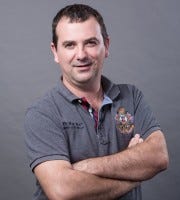Effective co-development really does make for better games
A recent chat with Richard Turek, one of our senior producers at Virtuos, on how the "exotic gameplay" approach to games development is different and what teams need to do to make co-development successful.

One of the great things about working at a studio like Virtuos is being able to work on some of the most prestigious and well-received games in the world. This especially true at a time when there’s a strong appetite from the world's biggest games studios to make bigger, deeper, better games. This can take many forms, including parallel development on multi- platforms, full level design, downloadable content packages – or even resurrecting classic titles through remakes on new platforms.
As a studio, Virtuos is increasingly developing full levels and what we call "exotic gameplay". Exotic gameplay is a term, coined a few years back, where game teams (through intelligent partnerships) can add quality, depth and substance to their projects, above and beyond what they may have scoped out with their internal resources.
I recently spoke with Richard Turek, one of our senior producers here at Virtuos about how this approach is different, and what teams need to do to make co-development successful.

INTEGRATED EXTERNAL RESOURCES
Richard Turek: We believe that our partners are seeking a lot more than a simple staffing solution for their ambitious projects, these days. They want passionate, diversely talented teams that can drive a project as hard as any internal development team, and become an integral part of the organisation.
This is especially true for parallel development projects where it is not just about making Art assets, weapons, vehicles and buildings, but about true co-development, where creative input and strategic decision making is a collaborative process between games companies and their external developers.
These companies now make it clear from the beginning that they aren't looking for a flexible talent pool, but an extension of their own development team; a partner just as dedicated as they are, to making the best game possible. The depth of the relationship reaches new levels, and when it comes to access to proprietary engines and pipelines deeply integrated between the two parties, trust is essential.
We therefore need to become true extensions of core dev teams. It's easier said than done, but there's a real need from developers to build these long-term partnerships, because nobody wants to micro-manage 10 or 20 different vendors! It takes time, because teams get to know each other on a different level – getting in deep on core tasks, like sharing the backlog, task progress and risk log as one team. The belief is that driving conversations across different departments: Art directors, tech directors, Design Director, leads to a greater chance of success and true integration.

GOAL SETTING AND ENABLEMENT
Game development can be fast and fluid, especially when the core teams are trying to "find the fun" to delight the end user. To achieve success, teams should expect rounds of iteration, and must plan for it and embrace it. Obviously when changes impact deadlines, sensible dialogue begins and the joint teams come up with options to achieve the best path for the game.
It's clear the mammoth games companies know how to make great games - but companies like us add value because we know how to do great project management. With over 1,000 projects under our belt, we really have seen it all!
Ultimately, AAA studios who want to make their games bigger while increasing their ROI need to rely on major partners for their expertise in specialized game development services as well as flexible development work.
We find that the key to successful AAA projects can often drill down to the strength of the personal relationships. Therefore, we truly believe in the continual flow of communications, dialogue, reporting and discussions across internal and external dev teams. If this is combined with a genuine will to be flexible and adaptable, at any stage of the project, good things start to happen – but it's truly on the developer to offer this flexibility and understanding to support the client's needs and even preempt them!

FLEXIBILITY AND THE PERSONAL TOUCH
It doesn’t need to be rocket science either. It can be as simple as taking the time to get to know team members properly. Getting to know one another can help tremendously as it builds deeper trust, and even friendship! Chances are there will be communication regularly with these people for the next one to two years. Being open and human can help to smooth communication while still being professional.
We also need to be adaptable and flexible so we’re working as an extension of the developer’s team. In the past we’ve completed projects that had a pre-existing, fairly unique, custom way of building levels. This process was completely new for our team but we were still eager to adapt to the way this partner worked so that we could integrate seamlessly into their pipeline.
Finally, a well-defined feedback loop can be critical to a project’s success, and should not only happen at the end of the project, but throughout the whole process. To find out what is and is not working and then ask for constructive feedback helps to improve relationships and make the project go smoother.
Sharing feedback early can save time and anguish at a later stage - there is no benefit to waiting until something is 100% complete before sharing opinions – and clients value the feedback. Providing updates throughout the creative process helps to give context and rationale for how to achieve the best possible results; highlighting issues encountered and how to fix them. Sharing early ensures expectations are met and allows partners to speak up if they think it is going in the wrong direction – saving everyone from wasting time and effort.

Successful co-production is so important to us, but as Richard points out, the basics of achieving healthy co-operation are actually quite simple. What matters is the drive of several teams to do all they can, and in their power, to initiate healthy collaboration and feel like one team. The "Them and Us" scenario is a long forgotten ancient history, and in this era of simple integration and easy communication, we should all be working closely together to create better games than ever before.
Read more about:
BlogsAbout the Author(s)
You May Also Like







.jpeg?width=700&auto=webp&quality=80&disable=upscale)








